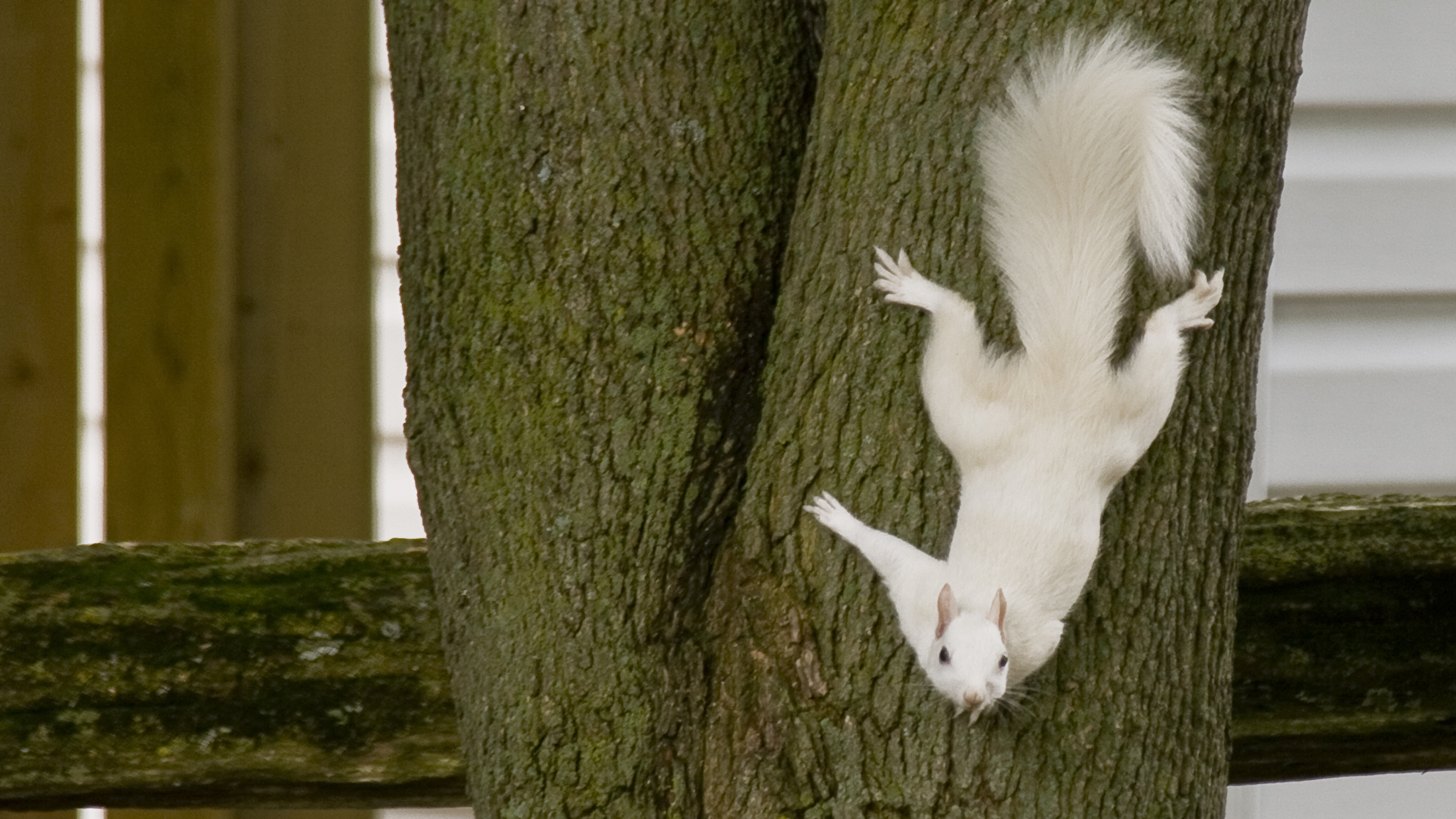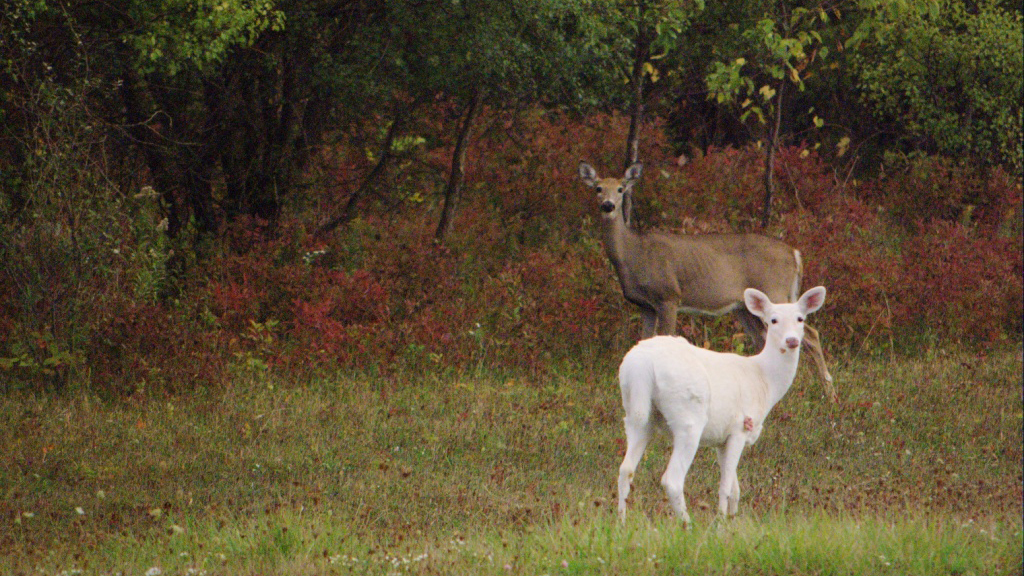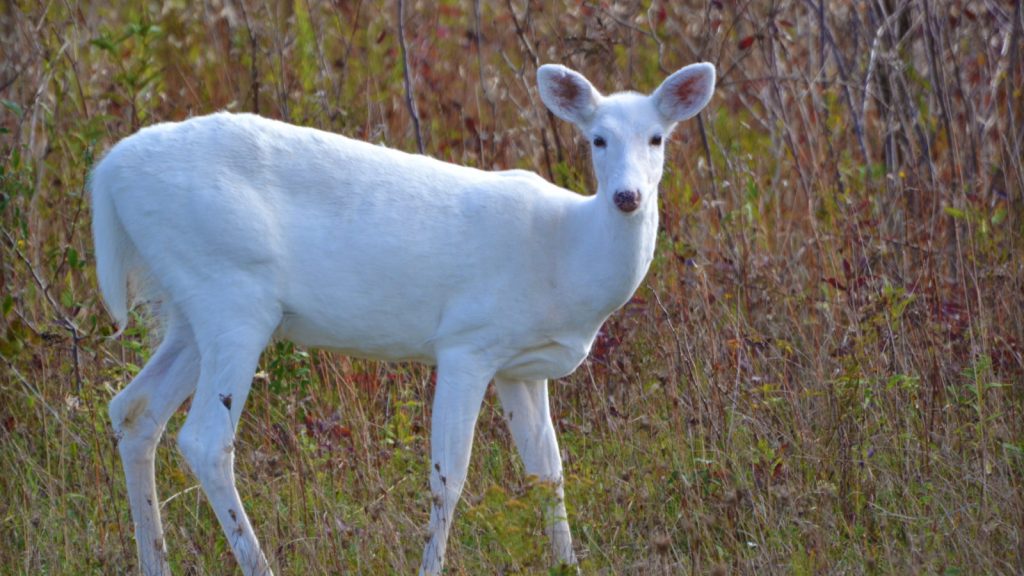You’re driving through your neighborhood and see the usual suburban white-tailed deer in a vacant field. You’ve been seeing these deer a lot more lately, so you hardly take notice. Then a flash of white catches your eye. A white deer.
You pull over to look at this striking, beautiful animal. It seems precious, rare. But what exactly is it?
It turns out people have been captivated by white deer for centuries, and perhaps millennia. The ghost-like appearance of these animals has attracted myth, superstition and rampant scientific misinformation for an equally long period of time.
That misinformation continues to this day. And it stands to reason that, with whitetails becoming more abundant near population centers, more people will be sharing their own tales of these unusual creatures.
Here’s the real story of the white deer.
The White Deer of Story
As a young boy, one of my earliest memories is visiting my grandparents’ home and waiting for my grandfather to return from an afternoon of hunting the nearby woods. The stories he told helped instill my lifelong love of field sports and wildlife.
One morning, he came in from a squirrel hunt with a big smile on his face. “No one is going to believe this,” he began. “But I saw something I’ve never seen today.”
He was sitting against an oak tree waiting for squirrels when a flash of white caught his eye. He looked to see a large, “albino” buck approaching him. The deer sniffed, catching his scent – but it didn’t flee. Instead, it trotted towards him, stopping just a few feet away. He stuck out his hand and the deer allowed him to scratch its forehead.
For several years, stories of this deer roaming around the woods of Snydertown, Pennsylvania were common. As a boy, I imagined encountering this mysterious beast. But decades later, with countless time spent observing and hunting deer, I have yet to see a white deer in the wild. But I still hear the stories, many of them strange or even mythical.
White deer are real, but they may not be what you think.
Albino, Leucistic or Piebald?
Most people, like my grandfather, refer to white deer as “albinos.” While deer can be albinos, it’s exceedingly rare.
Albinism is a congenital condition defined by the absence of pigment, resulting in an all-white appearance and pink eyes. Many plant and animal species exhibit albinism (including humans). It’s difficult to accurately determine how frequently this condition exists in wild animals, because albino animals tend not to survive long. They have poor eyesight and are conspicuous, making them easy prey. Research suggests that albino alligators, for instance, survive on average less than 24 hours after hatching.

The same undoubtedly holds true for deer, and in fact true albino deer are rarely reported. Instead, most white deer exhibit a condition commonly known as leucism, a recessive genetic trait found in about one percent of all white-tails. As with albinism, leucism can be found in nearly all mammals.
Leucistic animals lack pigment over all or part of their bodies Leucistic deer can be varying levels of white – some contain white splotches, some are half brown and half white, some appear nearly all white. Mixed brown and white animals are often known as piebald deer. (Confusingly, many deer biologists and hunters use “piebald” to describe all leucistic deer).
The nose is black, as in a “normal” deer, and eyesight is not usually affected.
Many other animals exhibit leucism. Birders often report seeing unusual white birds (rendering field guides nearly incomprehensible). White squirrels have become famous tourist attractions in several U.S. towns.
Leucistic deer generally can survive longer than albino deer. Still, they are not very well camouflaged in the forest, making them stand out to predators. In a habitat with its large predators still present, a leucistic deer’s chances of survival are slim.
As wildlife photographer and deer expert Leonard Lee Rue III notes in his recent book Whitetail Savvy (a must-read for deer nerds), “Many piebald deer also exhibit hunched backs, bowed legs, and short, rounded noses.”
![Piebald whitetail deer. By U.S. Fish and Wildlife Service [Public domain], via Wikimedia Commons](https://blog.nature.org/wp-content/uploads/2016/02/Piebald_whitetail_deer_animals_mammals_odocoileus_virginianus.jpg)
Today, human hunters are the most common large predator over much of the white-tailed deer’s range. Humans bring their own selection pressures to hunting, and they’re quite different from those of wolves or mountain lions.
I’d guess that, because of that, you’re more likely to see a white deer today than at any point in the whitetail’s history.
The Curse of the White Deer
Imagine a Pleistocene hunter peering over a hill to see a white deer – something the hunter would undoubtedly never have seen before. What is this animal? It looks other-worldly: an apparition.
It is easy to see how such an animal might be viewed as sacred and off limits. That belief has informed hunting habits and even regulations to this day.
One of the most persistent legends is that a hunter killing a white deer will experience a long run of bad luck, perhaps never bagging another deer. This idea seems almost universal among hunting cultures. Hunting writer Peter Flack notes in his book Kudu that hunters across Africa believe misfortune (sometimes including death) will befall any hunter who kills a white antelope.

When game regulations were comprehensively enforced in North America in the early 1900s, conservationists believed that rare wildlife needed to be protected. White deer qualified as rare, so many state game departments prohibited hunters from killing them. This regulation remains in effect in at least three states and parts of two others.
The most interesting example of white deer protection is Seneca Army Depot in New York. The military installation was surrounded by a fence in 1941, essentially creating a 10,600-acre deer preserve.
The white-tailed deer proliferated and GI’s began hunting them. The hunters began noticing a few white deer around (which were leucistic, not albino). In 1951, the depot commander established a rule protecting these white deer from hunting.
A fenced reserve protecting the animals from predators, hunters targeting brown deer and inbreeding associated with an isolated population allowed this genetic condition to proliferate. Today, an estimated 200-300 of the 800 whitetails on the property are leucistic. It’s likely the largest concentration of these deer to ever exist.
The depot is closed and the future of the property – which has high development value – is uncertain. What will happen to the white deer if and when the fences come down? As has been the case throughout history, many people desperately want to save these deer, recognizing in them rarity that should be protected. The property actually is quite important to wildlife (and people) well beyond the white deer, too — The Nature Conservancy in fact is exploring options for protecting this place with other groups and stakeholders. From conservation values to community impact, tourism, and economic development, there is much to consider. The Nature Conservancy’s goal is to bring science to this conversation and consider the ways this land could best benefit nature and people in the years ahead.

It seems that hunters in many parts of the country no longer have the cultural or legal prohibitions against shooting white deer. Many hunters find them interesting trophies. But society at large feels differently.
Hunters who kill albino and leucistic deer often find themselves the targets of internet outrage and even death threats. A hunter bagging a leucistic moose set off a firestorm of social media hate. Message boards fill with comments like “What kind of sick person kills such a rare animal?”
Many white deer protectors use the language of conservation: they see a rarity that should be protected, much as we would protect a California condor or black-footed ferret. Something so rare should never be killed by humans.
Let’s be clear, here. A leucistic or piebald white-tailed deer is a genetic anomaly. It would always be susceptible to predators, whether or not it was pursued by humans. The Seneca Army Depot is known for the white deer but there are actually many other reasons to protect it. These deer may indeed have cultural and historical value to humans, but let’s not confuse them with endangered species.
I too have been fascinated by these deer since hearing those stories by my grandpa. A white deer intrigues me as a student of deer. They’re fascinating to observe and ponder. But, in this era of over-abundant whitetails – when we desperately need scientific management to protect our forests and biodiversity – we must move beyond the idea of the white deer as a sacred beast.




ok then tell me how it is that i have video of solid white reindear in my yard.
Id like send the video Rockport TX
On 300 acres we are surrounded by other properties owned by people who hunt .
They simply see a “deer” to kill and eat or mount on a wall.
T hey also see deer that have been run over by a car.
Being a “trophy hunter” fills a need I have never understood, because a deer has never done anything to hurt them.
Over the years, 2 herds of deer have learned that they can “come home” here and be safe.
When they are wounded by a bow they come here to go in our lake to die….We help them to do that
This year a white buck showed up with his sister. They come every night between 7;30 and 8pm with 11 other friends and graze with our 3 horses.
Your information has helped me to pursue the information I need to learn more.
Thank you
I have one that visits my back yard almost every day. I live in Montgomery County, PA not far from Philadelphia.
We had a 2 pt. white tailed buck in our backyard that had mottled white and light brown fur and pink behind ears and pink skin around the eyes. Would it be a piebald (not like a spotted cow) or Leucism (not white either) deer? Certainly not like the normal cinnamon and white deer this time of year. How would you identify this deer?
.Good afternoon. I live in the Scottish highlands and have been hunting deer for 15 years .I come across the white deer.Trust me it does not act like other deer.It does not run but holds it ground .and will always look at you.Know lots of old hunters here and they all speak of the white deer.Not all story’s are good. Thought you might be interested.
I worked at the Seneca Army depot as a the visual information manager and photographer. I spent many hours observing the deer herd there. The Army had a controlled hunt every year and a certain amount of white deer could be taken. The fences remain since the depot closure. However, there are place where the fences are not as controlled as they once were. Seneca White Deer is trying to preserve the herd through bus rides for tourists. I hope they succeed.
Just found your article. At noon today, June 26, I spotted a completely white fawn in the suburbs of St. Louis. It crossed the street in front of me and joined a normal spotted fawn. I was not able to get a photograph. Now I wonder wether or not it was a true albino. It was pure white and the eyes were quite pink. It was a beautiful site as they met Nose to Nose.
A truly fascinating and informative article. I lived in the UP of Michigan for a few years and was walking the bike path around Marquette two summers ago when a stark white doe stepped out several feet in front of me, followed shortly by two normal spotted fawns. Struck mute and unable to move, I watched as she lightly stomped the paved path while continuing to stare at me. Time literally stood still as the three stood still there until the ‘babies’ sauntered off into the foliage on the other side. Mama watched me a long time, nose twitching, eyelashes pale in the sun. I never will forget how she finally just casually stepped off of the path and into the dense brush. As I continued on my walk, I saw her looking at me still through the relative safety of the trees. I never will forget that strange and beautiful encounter.
Ah, someone who uses common sense – refreshing.
I grew up 3 miles from the southwest corner of the depot. It was open then. Good article. These Deer Go Outside The fence All The Time. It Is Not Like THey Are Stuck In A Cage. Sometimes People Think Deer Cant Jump An 8ft Fence.
Want a wonderful afternoon…..saw a piebald deer at the river which runs through my yard…I feel so special to have seen this beauty of nature. This deer was with 2 brown deer just taking their time as they moved along. I am not sure if any people in our area ( Blairsville, GA) in the North Georgia Mountains has seen one.
Today, March 20, 2018, I saw a piebald deer. I was so excited as it moved along the river in north Georgia mountains (Blairsville, GA)….how wonderful to see such beauty of nature. It was with 2 more deer of natural color. They took their time wandering around my yard….loved every time of watching them.
Sunday, 3/4/18, 4:45 p. m.
We just saw a leucistic deer in our backyard feeding with about six or seven normal deer. Never have seen a deer like it previously even though we see deer daily on our property. It was splotched with about equally as much white as brown patches on it. We live on High Point, NC, which is about middle of NC. How rare are leucistic deer in our area?
Hi Steve and Melba, Thank you for the question! The New Jersey Division of Fish and Wildlife has some information on piebald deer: http://www.state.nj.us/dep/fgw/piebald.htm You might try contacting them to see if they have statistics on reports.
This was an informative article as I have never seen a white deer until yesterday (2-10-2018) in the woods just off my front yard. This beautiful deer was laying down and within 10-15 feet on either side were a total of 4-5 white tail deer as if protecting her. As I approached, they looked at me but did not run and I was able to take several pictures. They stayed on property for about 2 hours or so. I live just north of Sanford, NC on 3.2 acres. This was very special.
On my way home last night I encountered a white deer. I was on Plum Point Rd in Elkton, Maryland. There were 4 typically colored white tail deer and the white deer. I didn’t notice the color of the nose. The left side of the deer was completely white. I was unable to see the right side.